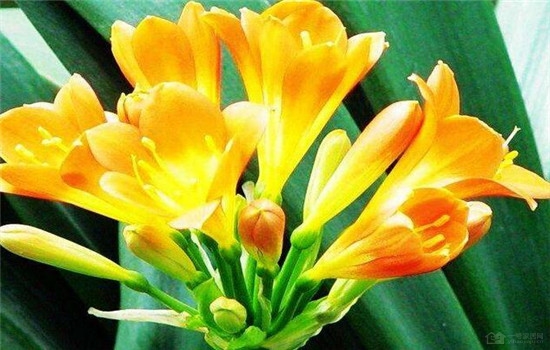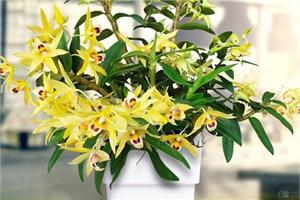Pay attention to five aspects of flower culture methods of Cymbidium.
Gentleman orchid name is beautiful, it is also a very beautiful flowers, many people will raise orchids in their own homes, through it to make home decoration more beautiful. Want to breed gentleman orchid this kind of flower to want to know its method, below recommend for you gentleman orchid flower breeding method.

1. Soil: Magnolia is suitable to use humus-rich soil, which has good air permeability, good permeability, fertile soil and slightly acidic (pH6.5). General gentleman orchid soil configuration, 6 parts of rotten leaf soil, 2 parts of pine needle, 1 part of river sand or ash, 1 part of base fertilizer (pockmarked, etc.). Rotten leaf soil mainly refers to oak leaves, also known as oak trees. This kind of leaf is thick in texture and is a good humus. Nutritious and permeable. Other leaves are so thin that they are gone after decay and cannot be mixed with other media. The pot used in cultivation increases gradually with the growth of the plant, and the 3-inch pot is suitable for the cultivation of one-year-old seedlings. Change 5-inch pots in the second year, and then change into larger flowerpots every 1-2 years, which can be carried out in spring and autumn.
2. Lighting: Magnolia is a moist plant, which is suitable to grow in high humidity, but it does not require high light, as long as the temperature is suitable, it does not matter if the light time is longer or shorter. Although good lighting can ensure the bright color of the gentleman orchid, it still likes a slightly weaker light, so be sure to avoid strong light.
3. Pour the basin: when the gentleman orchid grows up, you need to change a big basin for it. This is "pouring the basin and changing the soil". The best time to change soil is in spring and autumn, because the orchid grows vigorously at this time and will not affect the growth of the plant. The most important thing to change soil is to fill the root with soil, otherwise if there is no soil in the root, then water and nutrients will not reach the root, which is easy to cause rotten root.
4. Watering: Cymbidium has more developed fleshy roots, and the root memory stores a certain amount of water, so this kind of flower is more resistant to drought. However, drought-tolerant flowers should not be seriously short of water, especially in the case of high temperature in summer and dry air, do not forget to water in time, otherwise, the roots and leaves of flowers will be damaged, resulting in the germination of new leaves, and the original leaves are estimated to be scorched, not only affect flowering, but even cause plant death. However, too much watering will rot the roots. Therefore, it is necessary to have a good grasp and always pay attention to the dry and wet condition of the basin soil. if it is semi-dry, it should be watered once, but the amount of water should not be much. It is just right to keep the basin soil moist and not damp.
5. Fertilization: many flowers like fertilizer, but there should be a limit to fertilizer-loving flowers. Too much fertilization is disadvantageous to growth, and even plants will rot or scorch. Magnolia also belongs to this kind of plant and must be fertilized appropriately. Flowers have different nutrient requirements at different stages of growth and development. Therefore, different fertilization methods suitable for plant needs should be adopted in different periods. Such as applying base fertilizer, topdressing, extra-root fertilization and so on.
① base fertilizer (or base fertilizer): the purpose is to create conditions for plant growth and development to meet its nutrient needs. The application of base fertilizer for Magnolia should be carried out when the basin is changed every two years. Apply barnyard manure (that is, livestock manure), compost, green manure, bean cake fertilizer and so on.
② topdressing: mainly to promote plant growth. Gentleman orchid can apply fertilizer such as cake fertilizer, fish meal, bone meal and so on. Apply less at the beginning, and then the amount of fertilizer will gradually increase with the growth of the plant and the increase of leaves. When applying fertilizer, open the pot soil and apply it to the soil 2-3 meters deep, but be careful that the fertilizer should not be too close to the root system so as not to burn the root system. The application of this kind of solid fertilizer is generally enough once a month and should not be dense again.
③ topdressing liquid fertilizer: topdressing liquid fertilizer is that the supernatant of animals and plants that have been soaked and retted is mixed with 30-40% water and then poured on the basin soil. Small seedlings should be watered 40 times, medium seedlings 30 times, and large seedlings only 20 times. After pouring fertilizer solution for 1-2 days, we should continue to irrigate clear water (the amount of water should not be too much), so that the fertilizer can seep into the root system of the basin soil and give full play to the fertilizer effect. Do not water 1-2 days before the application of liquid fertilizer, so that the basin soil is relatively dry and then apply liquid fertilizer, which is more effective. Fertilization time is best in the early morning; when pouring, let the fertilizer liquid pour along the edge of the basin, pay attention to avoid applying on the plants and leaves. In addition, different fertilizers should be applied according to different seasons. For example, in spring and winter, it is appropriate to apply some phosphorus and potassium fertilizer, such as fish meal, bone meal, hemp cake, etc., which is conducive to the formation of leaf veins and improve the glossiness of leaves; while in autumn, it is appropriate to apply some leachate of rotten animal hair, horns, hooves or bean cakes and pour it with 30-40 times fresh water to promote leaf growth.
④ extra-root topdressing: this method of fertilization is mainly to make up for the lack of nutrients in the soil, in order to solve the problem of lack of fertilizer in the plant, so that the seedlings grow fast and the flowers and fruits grow fat. Extra-root fertilization is to spray the fertilizer diluent directly on the leaf surface of the plant and let the nutrient elements infiltrate into the leaf tissue through the leaf epidermis cells and stomata and then transport to the whole body of the plant. The commonly used fertilization varieties are urea, potassium dihydrogen phosphate, calcium superphosphate and so on. When spraying, spray evenly to both sides of the blade. In the growing season, it is sprayed once every 4-6 days and once every two weeks when it is semi-dormant. Generally, it is sprayed after sunrise, and the plant should be stopped after flowering. It must be noted that this method can only be used when the plant is found to be short of fertilizer. If the plant has sufficient nutrition and exuberant growth, it is not suitable to be used.
Cymbidium flower culture method as above, gentleman orchid compared with other flowers, has a "delicate" feeling, it needs to spend more time and energy than other flowers, have enough patience and energy to take care of them, so that they can grow healthily and beautifully.
- Prev

Culture method of potted green pineapple light and temperature of green pineapple
Culture method of potted green pineapple light and temperature of green pineapple
- Next

A complete knowledge of family flower farming to see how to raise plants you like.
A complete knowledge of family flower farming to see how to raise plants you like.
Related
- Wuhan Hospital Iron Tree Blooming Result Was Instantly Frightened by the Gardener Master
- Which variety of camellia is the most fragrant and best? Which one do you like best?
- What is the small blue coat, the breeding methods and matters needing attention of the succulent plant
- Dormancy time and maintenance management of succulent plants during dormancy
- Minas succulent how to raise, Minas succulent plant pictures
- What are the varieties of winter succulent plants
- How to raise succulent plants in twelve rolls? let's take a look at some experience of breeding twelve rolls.
- Attention should be paid to water control for succulent plants during dormant period (winter and summer)
- Watering experience of twelve rolls of succulent plants
- Techniques for fertilizing succulent plants. An article will let you know how to fertilize succulent plants.

